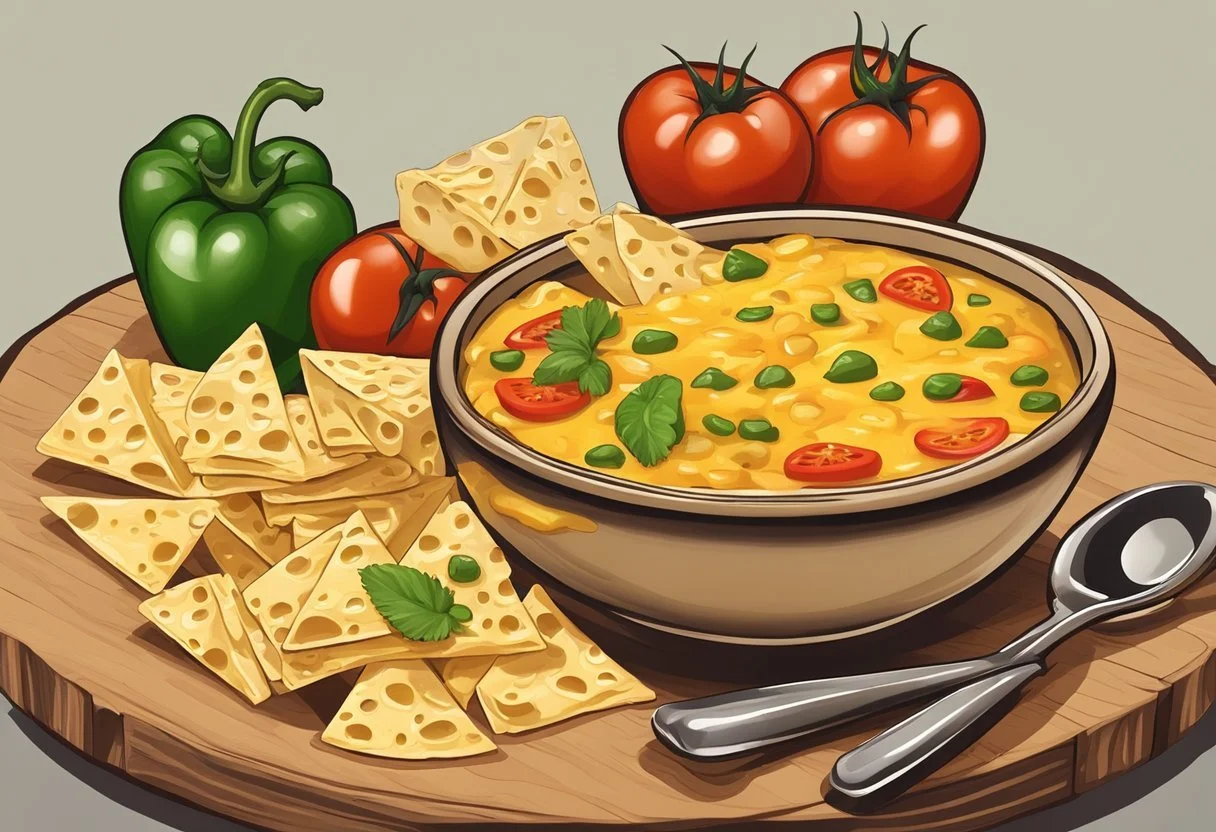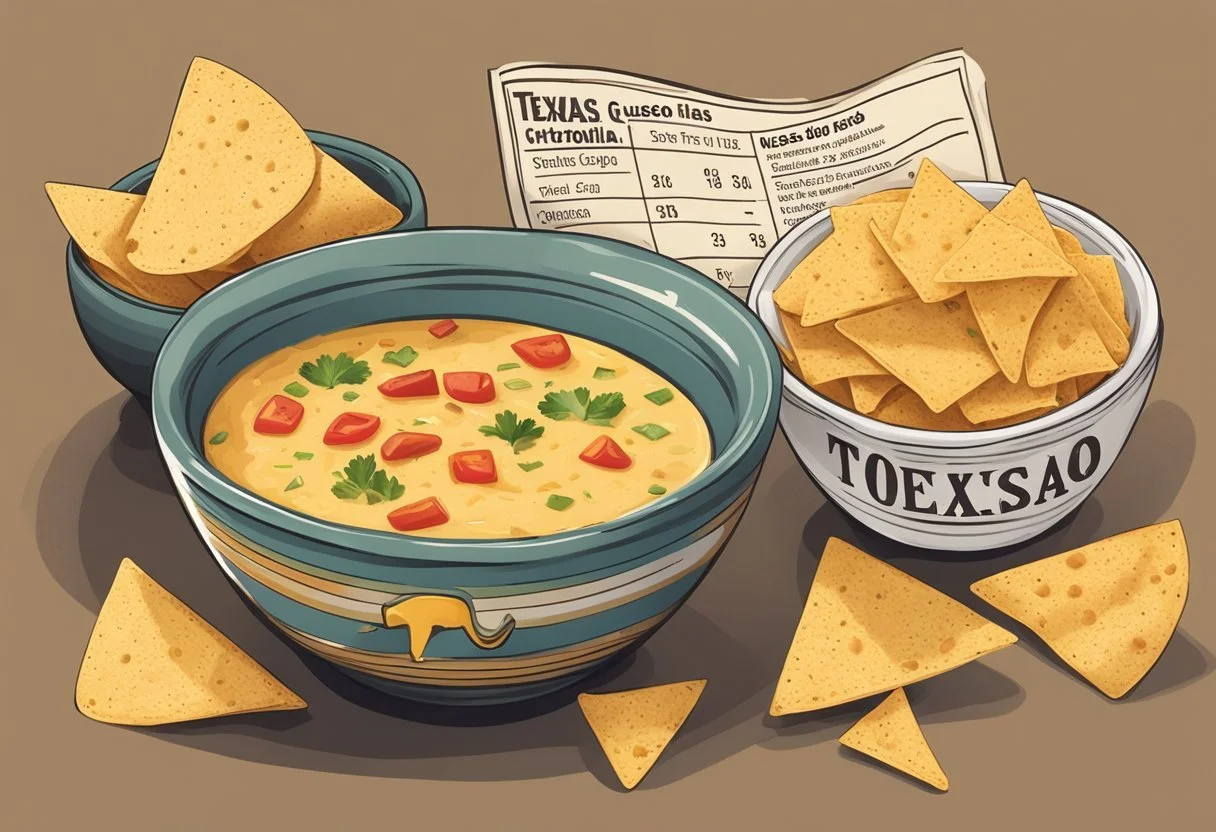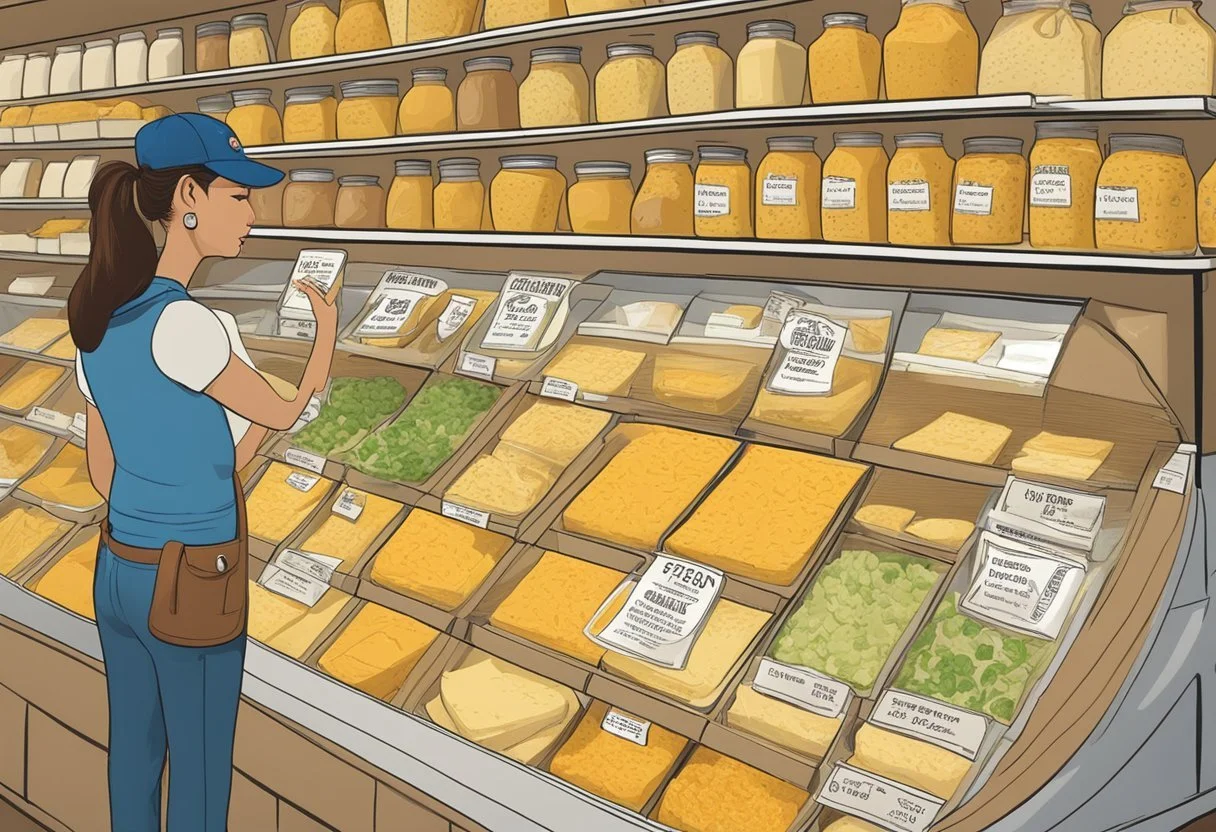Texas Queso
Authentic Recipe and Tips for Perfect Dip
Discover > Truly Texan > Texas Queso
Texas queso, a staple in Tex-Mex cuisine, has long been a favorite accompaniment to various dishes and snacks. This mouth-watering cheese (how long does cheese last?) dip is more than just a simple sidekick; it is the life of the party, bringing people together to indulge in its rich, creamy goodness. With its perfect blend of spices, melted cheese, and often a dash of chili powder, there is no denying that the queso recipe has been making a significant impact on the world of Mexican food. (What wine goes well with Mexican food?)
Tex-Mex cuisine, with its roots in the Rio Grande Valley, has evolved over time as a fusion of traditional Mexican and Texan flavors. Within this culinary landscape, Texas queso holds a special place that truly sets it apart from the other cheese dips. Going beyond the standard American nacho cheese, its distinct spices and ingredients give it the essence of Mexican food while still appealing to the American palate.
Traditionally made with a blend of melted cheeses, green chilies, and spices, queso can be customized to one's own preference by incorporating additional ingredients such as tomatoes, onions, (What wine goes well with onions?) or ground beef. The versatility of Texas queso makes it a favorite for home cooks and professional chefs alike, as it can be enjoyed in a variety of ways, from being served over nachos and tacos to being a dipping sauce for chips and vegetables. This iconic Tex-Mex dish brings warmth and flavor to any gathering, uniting friends and family over a shared love of delicious, satisfying Mexican cheese dip.
History of Texas Queso
Texas Queso or Mexican cheese is a popular dish with roots in both Tex-Mex and Mexican cuisine. Its history is a mix of Mexican culinary traditions with influences from the American frontier, making it a unique and flavorful experience.
The origins of Texas Queso can be traced back to early Mexican cuisine, where melting cheese with different accompaniments was common. The first recorded version of a cheese and chile dip comes from the 1896 Mexican Cook Book written by Josefina Velázquez de León. However, the addition of processed cheese, a distinctly American twist, transformed it into the smooth, creamy dish known as Texas Queso today.
The change from authentic Mexican queso to what is now recognized as Texas Queso was primarily influenced by the Tex-Mex culinary tradition. Tex-Mex developed in the border regions between Texas and Mexico during the late 19th century, as settlers from the United States introduced new ingredients to traditional Mexican recipes. This fusion of food styles soon spread to other parts of Texas and even beyond.
Below are a few key moments in the history of Texas Queso:
Early 1900s: In the early 20th century, a surge in the popularity of Mexican-style cheese dips occurred, particularly in Texas.
1920s: The American company Velveeta (how long does velveeta last?) introduced its processed cheese, which would become a staple ingredient in Chile con Queso recipes.
1930s: Tex-Mex restaurants in the United States started serving Queso as a popular appetizer on their menus.
1950s-1970s: Texas Queso gained national popularity, with cookbooks featuring the dish and supermarket versions of the dip becoming widely available.
The modern-day homemade Queso is made from a combination of cheeses (such as Velveeta, Pepper Jack or Monterey Jack), tomatoes, green chiles, and additional spices. While it might be considered a staple in many Tex-Mex restaurants, some variations of the dish are also served in authentic Mexican kitchens. The versatility and popularity of Texas Mexican cheese dip make it a beloved dish enjoyed by people all over the United States and beyond.
Ingredients
In this section, we will discuss the main ingredients that comprise homemade Queso. We will focus on the cheeses used in cheesy dips, common add-ins, and seasonings that create the delicious dish known and loved by many. So, what is queso dip made of?
Cheeses Used in Texas Queso
Several types of cheeses can be used in Texas queso dip recipe. What are the most used cheeses that queso dip made from?
American cheese: Yellow American cheese or block cheese is a popular choice due to its smooth and creamy texture. Although American cheese may have less flavor than other cheeses it excels at melting. So American cheese is ideal for cheese dips where it helps to create the melted texture needed. American cheese also melts at a lower temperature, which speeds up cooking.
Velveeta: A processed cheese product that melts easily and adds a unique flavor to the dish.
Cheddar cheese: Typically, a mild cheddar cheese is used, but you can experiment with stronger flavors if desired.
Queso fresco: This fresh cheese can be crumbled on top of the Mexican cheese dip for added texture and flavor.
In addition to these cheeses, you can choose your own cheese while some recipes may call for a combination of cheeses, such as cream cheese, to create a more complex flavor profile.
Generally, homemade queso begins with a base of whole milk, melted butter, and a thickening agent like cornstarch (how long does cornstarch last?) or flour to create a smooth, creamy sauce. Use pre-shredded cheese to speed it up as the cheese melts.
Evaporated milk (how long does evaporated milk last?): Some recipes suggest using evaporated milk instead of milk. Evaporated milk is denser and helps keep the dip thick and creamy. When evaporated milk is combined with cornstarch it also helps to stop the dip from congealing over time. Evaporated milk has a rich caramelized flavor which goes well with the other dip ingredients.
Common Add-Ins
To customize and enhance the flavor of the dish, various ingredients can be added. Some common add-ins include:
Onion or onion powder: (how long does onion powder last?) Diced or finely chopped, onions add a slight sweetness and texture. For convenience, onion powder (how long does onion powder last?) is a good substitute. Use sparingly as dehydrated onion powder is stronger than fresh.
Garlic powder: (how long does garlic powder last?) Similarly, fresh garlic is ideal but if time is short garlic powder will substitute well.
Jalapeños: These peppers provide a spicy kick without overpowering the dish. They can be fresh or pickled. Alternatively use hot sauce (how long does hot sauce last?) in your cheesy dip.
Tomatoes: Finely chopped tomatoes add color and a mild tanginess to the queso.
Green chiles: Roast and finely chop green chiles contribute an earthy, slightly spicy flavor.
These are just a few examples of ingredients one could add to a homemade queso recipe. The possibilities are vast and can be tailored to individual tastes.
Online shopping for onion powder is the smart choice for a seamless transaction!
Seasonings
The perfect blend of seasonings helps elevate the flavors of the white queso recipe. Common seasonings include:
In this section, we will explore different cooking methods for preparing Texas cheese dip. With a simple cooking technique, you can create a delicious homemade queso dip that will impress your friends and family. We will cover different techniques for making queso dip including stovetop preparation, the slow cooker technique, and baking Texas white cheese dip.
Stovetop Preparation
Stovetop preparation is a popular method for making Texas cheese dip. It allows for quick and easy cooking, perfect for when you need a tasty dish in a hurry. To begin, heat a medium saucepan or skillet over medium heat. Once heated, add a small amount of butter to the pan and allow it to melt. Once the butter has melted, proceed with your queso dip recipe, adding ingredients such as cheese, whole milk, tomatoes, and spices to the saucepan and stirring constantly until the cheese is melted. Keep heating over a medium heat but be sure to stir the queso dip mixture frequently to avoid burning or sticking to the pan. Once all the ingredients are well combined and the cheese has melted, your queso dip is ready to serve warm. If it's slightly too thick just add a little more milk and stir.
Take advantage of the wide variety of options when you shop for saucepan or skillet online!
Slow Cooker Technique
For an easy queso dip, use a slow cooker, which is a great option for those hosting a party or gathering, as it allows the queso dip to stay warm so it can be enjoyed throughout the event. To begin, layer all your ingredients in the slow cooker, starting with cheese, then vegetables, whole milk and finally, seasonings. It's important to cook the queso on low heat to avoid scorching the cheese. The cooking time will vary depending on your slow cooker, but a typical range is between 2-3 hours. When your queso dip is fully melted and blended, switch the slow cooker to the "warm" setting to maintain the perfect queso dip temperature.
Baking Texas Queso
If you're interested in a more traditional, Tex-Mex twist with your queso dip, try making queso flameado which utilizes the baking method. Preheat your oven to 375°F (190°C) and prepare a baking sheet by lining it with foil. In a skillet, cook your desired ingredients, such as chorizo, onion, and poblano peppers. When they are cooked through, transfer them to the prepared baking sheet. Layer shredded cheese on top of your ingredient mixture and place the baking sheet in the oven. Keep a close eye on your queso as it bakes; it generally takes about 5-10 minutes for the cheese to melt and become bubbly. Once the cheese has melted and started to brown slightly, remove the baking sheet from the oven. Your queso flameado is ready to be enjoyed; just be sure to use caution when handling the hot dish.
Get the best value for your money by purchasing a baking sheet online!
Serving Texas Queso
Accompaniments
Texas queso is a delightful dipping experience that showcases a melange of flavors and textures. The best way to accentuate its richness is by pairing it with appropriate accompaniments. Some popular options include:
Tortilla chips or corn chips (how long do corn chips last?): The most classic and widely appreciated companion for queso dip. Choose sturdy tortilla chips (how long do tortilla chips last?) or corn chips that won't break under the weight of the queso dip. Mexican restaurant's tortilla chips are often thicker as they're used for tacos and enchiladas. Try to find a brand that makes thicker tortilla chips.
Salsa, guacamole, and pico de gallo: These refreshing dips complement the creamy, cheesy flavors of queso, creating a well-rounded assortment for your guests to enjoy.
Barbecue: Texas-style barbecue and Mexican cheese dip make a mouth-watering combination, with the smoky flavors of the grilled meats being enhanced by the creaminess of the cheese.
Vegetarian options: For those with dietary restrictions, raw vegetables – like carrots, celery, and bell peppers – can act as a tasty and nutritious alternative to chips or meats.
Keep in mind that a well-curated ensemble of accompaniments for Texas queso dip can set the tone for a memorable party or restaurant experience!
Presentation Tips
Employ these simple yet effective tips to elevate your Mexican cheese experience:
Emphasize variety: Provide an assortment of accompaniments (as listed earlier), ensuring everyone has something to enjoy.
Use appropriate dishware: Serve the Mexican cheese in a bowl that retains heat, preventing the dip from cooling too quickly. When catering to a larger party, consider using Crock-Pot-style serving dishes that can keep the Mexican cheese warm for a longer duration.
Arrange thoughtfully: Group the accompaniments on a platter, making certain each option is easily accessible to guests.
Garnish: Enhance the visual appeal of your Texas queso by adding a garnish, such as a sprinkle of fresh cilantro or sliced jalapeños.
Remember, pairing your well-presented Texas queso with a round of ice-cold margaritas can complete the ensemble and entice your guests to keep coming back for more!
Variations of Texas Queso
Regional Twists
In the vast state of Texas, queso or Mexican cheese recipes often have slight variations depending on the local flavors and preferences. One notable difference is the use of onions in the Mexican cheese. In some regions, white onion is used while in others, you may find dishes using green onions or even red onions.
Some Texas queso recipes also feature additional ingredients that give the dish a unique twist, such as:
Diced tomatoes: Common in Tex Mex queso, these add a burst of color and freshness.
Cherry tomatoes: Less common but still occasionally used in some recipes, these can be halved or quartered for a different texture.
Bacon: The smoky flavor of bacon adds a rich, meaty dimension to the Mexican cheese.
Jalapenos: Traditional Mexican cheese often includes jalapenos, but some cooks may use other peppers or add more spices for an extra kick.
Creative Additions
In addition to regional twists, many cooks like to experiment with creative additions to their Mexican cheese recipe. Beyond the usual suspects like onions and tomatoes, these innovative ingredients can add new layers of flavor and texture:
Black beans: Popular in Tex Mex cuisine, black beans (how long do black beans last?) add protein and heartiness to the Mexican cheese .
Spinach: A healthy dose of greens brings extra nutrients and a pop of color.
Chopped cilantro: This fragrant herb adds a fresh, zesty touch to the dish.
Chorizo: Crumbled and cooked chorizo brings a spicy, savory taste that pairs wonderfully with the creamy Mexican cheese.
Overall, the variations of Texas queso recipes demonstrate the flexibility and adaptability of this beloved dish. Whether you prefer classic Tex Mex flavors or crave something more adventurous, there is a Mexican cheese recipe out there to suit your taste buds. And to reheat queso dip? Transfer the cooled leftovers to a microwave-safe bowl and reheat in 30-second bursts. Test the heat before eating.
Nutritional Information
Texas queso is a popular and flavorful dish enjoyed by many. In terms of calories, a serving of Mexican cheese typically contains around 100-150 calories, depending on the specific recipe and ingredients used.
One important factor is the type of cheese used in the Mexican cheese . Many recipes call for queso fresco, a fresh and mild Mexican cheese that crumbles easily. Queso fresco brings a unique taste and texture to the dish. In comparison to other types of cheese, queso fresco is generally lower in fat and calories, contributing to a healthier option for your Mexican cheese.
When considering one's diet, it's crucial to account for the added ingredients, such as peppers, tomatoes, and spices. These can contribute essential vitamins and minerals to the dish without significantly increasing caloric content. Opting for low-fat milk or milk alternatives can also help reduce calorie intake and make the Mexican cheese more diet-friendly.
For vegetarians, Texas queso is a suitable option as it doesn't typically contain meat. However, it's always crucial to check the ingredient list to ensure no animal-based products, like gelatin, are included.
In conclusion, Texas queso can be enjoyed as a moderately indulgent treat that complements various meal plans. Concerning calories and diet, making smart ingredient choices can significantly impact its nutritional value. By utilizing queso fresco and fresh vegetables, this delicious dish can be tailored to fit the preferences of vegetarians and those conscious of their calorie consumption.
Buying Guide
Cheese Alternatives
For those with dietary restrictions or preferences, there are non-dairy and vegan options available to still enjoy delicious Mexican cheese.
Non-Dairy: Non-dairy cheese alternatives made from plant-based ingredients are available in a variety of textures and flavors. Look for a product that specifically mentions "melts well" to achieve the desired consistency in your Mexican cheese.
Vegan options: Although traditional Mexican cheese is made with dairy products, there are vegan alternatives that can achieve a similar taste and texture. Nutritional yeast (how long does nutritional yeast last?), for example, can be used as a cheese alternative due to its distinct cheesy flavor.
Although it may take some experimentation to find the perfect cheese alternative, there are plenty of options available to suit every preference while maintaining the essence of a delicious Texas queso.






